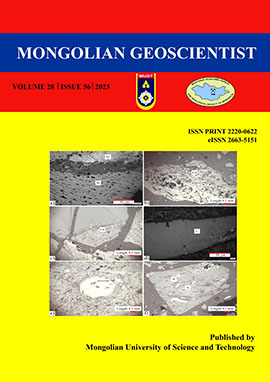Velocity analysis of a lateral wave
DOI:
https://doi.org/10.5564/mgs.v28i56.2794Keywords:
FDTD simulation, electromagnetic wave, CMPAbstract
In practice, the reflected EM signal cannot be clearly observed in GPR data due to the high water content and other reasons. However, the antenna coupling signal through the ground interface is dominated in all the GPR measurements. This direct coupling signal that travels through the ground interface is called a lateral wave. The properties of the lateral wave directly depend on the subsurface properties, especially electrical parameters. We have numerically analyzed a lateral wave and its velocity. Subsequently, the relationship between lateral wave and dielectric permittivity was determined by polynomial regression. Analytically, it is challenging to analyze a lateral wave due to the parameters that can influence wave propagation. Antenna characteristics, surface roughness, etc need to be considered. Numerically, we designed a GPR system with a subsurface layer and observed a lateral wave. This numerical analysis can give a chance to use a lateral wave for near-surface soil water content. This analysis gives a more precise estimation of surface water content. Moreover, we analyze the antenna height effect that influences radar signals. We numerically observed that the GPR signal is highly affected by antenna height. The antenna height effect depended on the wavelength of the applied electromagnetic wave. By adjusting the antenna height, the unobservable GPR signal can be clearly detected.
Downloads
324
References
Annan, A.P. 1973. Radio Interferometry Depth Sounding: Part I -Theoretical Discussion. Geophysics, v. 38(3), p. 557-580. https://doi.org/10.1190/1.1440360
Bradford, J.H., Deeds, J.C. 2006. Ground-penetrating radar theory and application of thin-bed offset-dependent reflectivity. Geophysics, v. 71(3), K47. https://doi.org/10.1190/1.2194524
de Coster, A., Lambot, S. 2019. Full-Wave Removal of Internal Antenna Effects and Antenna-Medium Interactions for Improved Ground-Penetrating Radar Imaging. IEEE Transactions on Geoscience and Remote Sensing, v. 57(1), p. 93-103. https://doi.org/10.1109/TGRS.2018.2852486
Gerhards H., Wollschläger, U., Yu, Q., Schiwek, P., Pan, X., Roth, K. 2008. Average Soil-Water Content with Multichannel Ground-Penetrating Radar. Geophysics, v. 73(4), p. 15-23. https://doi.org/10.1190/1.2943669
King, R.W.P., Owens, M., Wu, T.T. 1992. Lateral Electromagnetic Waves. Theory and Applications to Communications, Geophysical Exploration, and Remote Sensing. 1st ed, New-York, Springer-Verlag, ISBN: 978-1-4613-9174-6
Sato, M., Takahashi, K., Asaya, Y., Iitsuka, Y. 2015. Radiation of electromagnetic wave from an antenna placed close to a boundary of materials, Simulation of GPR antenna. IEICE Technical Report, EMT2015-20, v. 115(141), p. 65-70.
Shavit, R., Rosen, E. 1995. Lateral wave contribution to the radiation from a dielectric half medium. IEEE Transactions on Antennas and Propagation, v. 43(7), p. 751-755. https://doi.org/10.1109/8.391154
Zou, L., Yi, L., Sato, M. 2020. On the Use of Lateral Wave for the Interlayer Debonding Detecting in an Asphalt Airport Pavement Using a Multistatic GPR System. IEEE Transactions on Geoscience and Remote Sensing, v. 58(6), p. 4215-4224. https://doi.org/10.1109/TGRS.2019.2961772
Downloads
Published
How to Cite
Issue
Section
License
Copyright (c) 2022 Tsogtbaatar Amarsaikhan, Motoyuki Sato

This work is licensed under a Creative Commons Attribution 4.0 International License.
Copyright on any research article in the Mongolian Geoscientist is retained by the author(s).
The authors grant the Mongolian Geoscientist a license to publish the article and identify itself as the original publisher.

Articles in the Mongolian Geoscientist are Open Access articles published under a Creative Commons Attribution 4.0 International License CC BY.
This license permits use, distribution and reproduction in any medium, provided the original work is properly cited.








